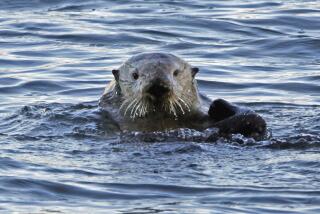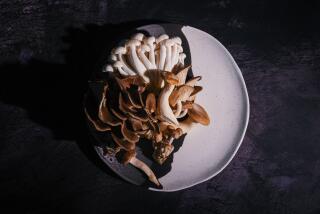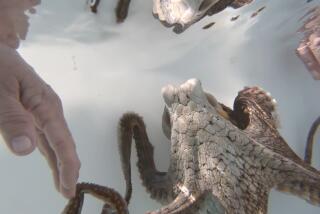Oysters Recommended as Sustenance for Africa : ‘Inexhaustible Quantities’ of Protein-Rich Mollusks Could Feed the Masses
- Share via
GAZI, Kenya — In a secluded creek beside the Indian Ocean, a marine biologist from Belgium toils in the brackish water and dreams of a new high-protein food for Africa’s undernourished masses--oysters.
“The snob appeal attached to oysters should be destroyed,” Prof. Philip Polk, dean of biology at the Free University of Brussels, said as he worked with two Kenyan assistants in the green water of Gazi creek, south of Mombasa.
“The protein content of oysters is far superior to that of any red meat or even fish,” he said, “and here are oysters in inexhaustible quantities.”
Polk, stripped to the waist and burned brown by the fierce equatorial sun, said he wants the world’s private and international development agencies, like the United Nations Children’s Fund, to consider oysters a basic food.
‘Versatile, Transportable’
“Third World families should be encouraged to feed their babies with oysters,” Polk said. “Oysters as a food are versatile and easily transportable. They can be dried, packed, canned or mixed with other food.”
Polk came to Kenya 18 months ago to supervise 20 Belgian-funded marine and aquaculture projects ranging from coral reef protection to plankton and algae classifications.
He found oysters flourishing wild, growing in mangrove outcrops in the estuaries and freshwater inlets that dot the Kenyan coast.
The lush tropical vegetation on the shoreline where fresh and sea water meet has helped create a natural reservoir of brackish water swarming with plankton and other nutrients, a perfect habitat for oysters, other mollusks and crustaceans, Polk said.
‘Viable, Lucrative Industry’
“What you see here is the beginning of a viable, lucrative industry for this country,” Polk said, pointing to the 90,000 oysters that he and Kenyan assistants Renison Ruwa and Michael Ngoa are cultivating.
From a collection of wooden frames in the mud beside the Gazi waterfront, Polk hopes to see Kenya break the dominance of Japan, France and Spain in producing the world’s annual oyster supply of 800,000 tons.
The wild Kenyan oyster is currently unsuitable for export because it is about half the size of the European variety, a result of the Mombasa coast’s crowded oyster colonies.
Polk is seeking to change this.
‘Room to Expand’
“We transplant them onto culture beds where each oyster has room to expand,” he said. “They should grow as big as, if not bigger than, the European or Japanese variety.”
He aims to sell his initial harvests to the dozens of luxury tourist hotels along the coast, where about 300,000 affluent West Germans, Italians, Britons and Scandinavians vacation each year.
“The hotels have expressed keen interest,” said Ruwa, 32, who is studying for his doctorate in marine ecology under Polk. “But we have a year to go before our first harvest.”
The cash earned with the first harvests will be used to teach villagers living on the creeks and estuaries how to create oyster beds, which could later be expanded for shrimp and lobster farming, Polk said.
Ardent Conservationist
Polk, who says he loves “the sea, Bach and French cuisine--in that order,” is an ardent conservationist. He would like to see the young men of the villages, who make their living collecting and selling seashells to tourists, switch to oyster farming.
“But you cannot urge the government to ban the sale of these rare shells unless you have a more lucrative alternative for the mostly unemployed school-leavers,” he said.
Asked if he was not being too ambitious, Polk said: “In 1978 South Korea did not produce a single commercial oyster. Today, it is the world’s fourth-biggest producer, harvesting over 70,000 tons a year both for export and the home market.”
Polk believes that Kenya and other African states venturing into commercial oyster production will have a big advantage because European oyster beds are being contaminated by industrial waste and pollution.
Senegal’s Harvest
Senegal is the only African country that currently produces oysters commercially, harvesting about 200 tons annually, mostly culled from the wild.
At present, Kenyans do not eat oysters. Polk is all in favor of encouraging them to develop a taste for the prolific mollusk. He sees it as a much underrated, potentially cheap source of protein that could greatly improve their diet.
Polk is trying to persuade the Kenyan government to promote oyster cultivation for local consumption.
More to Read
Sign up for Essential California
The most important California stories and recommendations in your inbox every morning.
You may occasionally receive promotional content from the Los Angeles Times.













